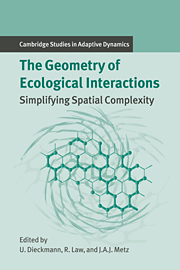Book contents
- Frontmatter
- Contents
- Contributing Authors
- 1 Introduction
- Part A Empirical and Statistical Background: A Plant Ecological Perspective
- Part B When the Mean-field Approximation Breaks Down
- Part C Simplifying Spatial Complexity: Examples
- Introduction to Part C
- 12 Spatial Scales and Low-dimensional Deterministic Dynamics
- 13 Lattice Models and Pair Approximation in Ecology
- 14 Moment Approximations of Individual-based Models
- 15 Evolutionary Dynamics in Spatial Host–Parasite Systems
- 16 Foci, Small and Large: A Specific Class of Biological Invasion
- 17 Wave Patterns in Spatial Games and the Evolution of Cooperation
- Part D Simplifying Spatial Complexity: Techniques
- References
- Index
- International Institute for Applied Systems Analysis
Introduction to Part C
Published online by Cambridge University Press: 14 January 2010
- Frontmatter
- Contents
- Contributing Authors
- 1 Introduction
- Part A Empirical and Statistical Background: A Plant Ecological Perspective
- Part B When the Mean-field Approximation Breaks Down
- Part C Simplifying Spatial Complexity: Examples
- Introduction to Part C
- 12 Spatial Scales and Low-dimensional Deterministic Dynamics
- 13 Lattice Models and Pair Approximation in Ecology
- 14 Moment Approximations of Individual-based Models
- 15 Evolutionary Dynamics in Spatial Host–Parasite Systems
- 16 Foci, Small and Large: A Specific Class of Biological Invasion
- 17 Wave Patterns in Spatial Games and the Evolution of Cooperation
- Part D Simplifying Spatial Complexity: Techniques
- References
- Index
- International Institute for Applied Systems Analysis
Summary
Because individuals react only to their local environment, ecological interactions are intrinsically spatial. It is the local environment that affects light absorption, nutrient or food intake, and predation risk, thereby indirectly impinging on growth, births, deaths, and movements. Part A showed how, in real life, the local environment is influenced more by near neighbors than by neighbors at greater distances. Various examples presented in Part B showed that these local ecological interactions can have a dramatic influence on population dynamics. Clearly, mean-field approximations can tell only a small part of the ecological story.
Each example discussed in Part B represents an ecological or evolutionary problem worth studying in its own right. Yet it is natural to want to go further and ask to what extent the relationships that emerge apply to more general classes of ecological processes. The resulting research program aims at determining which features in the interplay of mechanisms are essential for the occurrence of particular phenomena and which are coincidental.
This agenda can be approached from two perspectives, an intuitive and a formal one. (Actually these are just extremes of a continuum of research strategies in which both components figure in different proportions.) Intuitive approaches seek appropriate metaphors drawn from our physical or geometrical imagination. If used unaided by more formal tools, these approaches have two drawbacks: their unsystematic character severely limits their scope in complicated settings, and the resulting insights are not always trustworthy.
Information
- Type
- Chapter
- Information
- The Geometry of Ecological InteractionsSimplifying Spatial Complexity, pp. 204 - 208Publisher: Cambridge University PressPrint publication year: 2000
